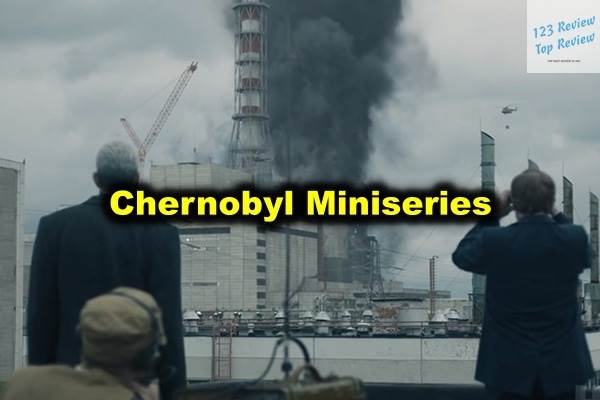Created by Craig Mazin and directed by Johan Renck, the five-part Chernobyl Miniseries delves deep into the catastrophic events that unfolded at the Chernobyl Nuclear Power Plant, as well as the far-reaching consequences for those involved.

In this article, 123 Review examines the series’ reception, its historical accuracy, character portrayals, themes, cinematic techniques, and the impact it has had on public awareness and global discussions.
Overall Reception
Audience Response
The “Chernobyl” miniseries struck a powerful chord with audiences worldwide, evoking strong emotional responses and prompting widespread discussions. The show’s intense, unflinching depiction of the disaster captivated viewers, who found themselves both horrified and moved by the tragedy. Social media platforms buzzed with reactions, as viewers expressed their shock at the events depicted and admiration for the series’ storytelling. The emotional weight of the series resonated deeply, particularly because it shed light on a disaster that, for many, had been only vaguely understood or remembered. The series also sparked interest in the Chernobyl Exclusion Zone, leading to a significant increase in “dark tourism” as people sought to witness firsthand the site of the disaster.
Critical Acclaim
Critically, “Chernobyl” was hailed as one of the finest television dramas of the 21st century. It garnered widespread praise for its meticulous attention to detail, powerful performances, and the emotional depth of its narrative. The series won multiple awards, including several Primetime Emmy Awards, with particular recognition for its writing, direction, and acting. Jared Harris, who portrayed the scientist Valery Legasov, and Stellan Skarsgård, who played Soviet politician Boris Shcherbina, were lauded for their compelling performances that brought nuance and humanity to their characters. Critics highlighted the series’ ability to weave historical accuracy with gripping drama, making it both an educational experience and an emotionally impactful one.
Historical Accuracy
Real Events vs. Dramatization
“Chernobyl” walks a fine line between historical accuracy and creative dramatization, striving to balance factual integrity with the demands of compelling storytelling. While the series remains true to the broad contours of the Chernobyl disaster, certain events and timelines were adjusted for narrative clarity and dramatic effect. For instance, the show condenses the timeline of the disaster’s aftermath and simplifies some of the complex scientific explanations to make the story more accessible to a general audience. Some dramatic liberties were taken, such as the depiction of certain high-stakes meetings and the intensity of certain confrontations, to heighten the emotional impact and underscore the gravity of the situation. Despite these adjustments, the series is widely regarded as one of the most accurate dramatizations of a historical event, respected for its commitment to capturing the essence of the tragedy.
Key Historical Figures Representation
The portrayal of key historical figures in “Chernobyl” has been both praised and scrutinized for its balance between authenticity and dramatization. Valery Legasov, portrayed by Jared Harris, emerges as the moral center of the series. Legasov’s role in the investigation and his ultimate decision to expose the truth about the disaster is depicted with a deep sense of responsibility and inner turmoil. This portrayal aligns closely with historical accounts of Legasov’s actions, although the series amplifies his role as a solitary hero to fit the narrative arc.
The character of Ulana Khomyuk, played by Emily Watson, represents a composite of several Soviet scientists who contributed to the disaster’s investigation. While Khomyuk is a fictional creation, her character embodies the tireless efforts of real scientists who worked to understand and mitigate the effects of the explosion. This creative choice allows the series to streamline the narrative while honoring the collective efforts of these unsung heroes.
Other characters, such as Boris Shcherbina and Anatoly Dyatlov, are portrayed with a blend of historical accuracy and dramatic interpretation. Shcherbina, initially depicted as a loyal Soviet bureaucrat, undergoes a significant transformation as he grapples with the reality of the disaster. His portrayal highlights the complexity of Soviet officials who, despite their flaws, were also victims of the system. Dyatlov, portrayed as the obstinate and reckless deputy chief engineer, is shown in a more villainous light, reflecting the real-life controversy surrounding his actions on the night of the disaster. However, this portrayal has been critiqued for oversimplifying his character and downplaying the systemic issues that contributed to the catastrophe.
Character Analysis
Valery Legasov and His Role
Valery Legasov, as depicted in “Chernobyl,” serves as the series’ moral and intellectual compass, guiding viewers through the complexities of the disaster. Legasov is portrayed as a man of science and integrity, who is deeply troubled by the systemic failures that led to the explosion and the subsequent cover-up. His character arc is marked by increasing disillusionment with the Soviet regime, culminating in his courageous decision to reveal the truth, even at great personal cost. Jared Harris’s portrayal of Legasov is both restrained and powerful, capturing the internal conflict of a man who is torn between his duty to the state and his responsibility to the truth. The real Legasov’s posthumous release of his tapes, in which he exposed the flaws in the Soviet nuclear program, adds a poignant layer to his character in the series, emphasizing the tragic heroism of a man who ultimately sacrificed everything for the greater good.
Ulana Khomyuk: A Composite Character
Ulana Khomyuk, a character created for the series, serves as a narrative device to represent the collective efforts of the scientific community in the aftermath of the Chernobyl disaster. Khomyuk’s character embodies the determination, intelligence, and moral clarity of the scientists who worked tirelessly to uncover the truth about the explosion and its causes. Through Khomyuk, the series explores the ethical dilemmas faced by these scientists, who had to navigate a treacherous political landscape while trying to prevent further catastrophe. Emily Watson’s portrayal of Khomyuk is both fierce and empathetic, providing a counterbalance to the often oppressive and secretive Soviet bureaucracy. Her interactions with Legasov and Shcherbina add depth to the narrative, highlighting the importance of collaboration and the courage it took to stand up to a system that prioritized secrecy over safety.
Examination of Secondary Characters
The secondary characters in “Chernobyl” play crucial roles in enriching the narrative and providing a more comprehensive view of the disaster’s impact. Boris Shcherbina, played by Stellan Skarsgård, is initially introduced as a hardline Soviet politician tasked with managing the crisis. However, as the series progresses, Shcherbina evolves into a more nuanced character who comes to understand the full horror of the situation. His relationship with Legasov is particularly compelling, as it evolves from one of mutual distrust to a partnership built on shared purpose and grim determination.
Lyudmilla Ignatenko, portrayed by Jessie Buckley, represents the human cost of the disaster. Her story, based on real-life accounts, is a heartbreaking portrayal of the personal tragedies that unfolded in the wake of the explosion. As the wife of a firefighter who was among the first responders, Lyudmilla’s experiences underscore the devastating effects of radiation exposure and the profound personal losses endured by those closest to the disaster.
Anatoly Dyatlov, played by Paul Ritter, is depicted as the villainous deputy chief engineer responsible for the fateful test that led to the explosion. His portrayal has sparked debate, with some viewing him as a symbol of the systemic arrogance and incompetence that plagued the Soviet Union, while others argue that his character is oversimplified. Dyatlov’s depiction in the series raises important questions about individual accountability versus systemic failure, highlighting the complex web of factors that contributed to the disaster.
Themes and Messages
The Cost of Lies
One of the most powerful and pervasive themes in “Chernobyl” is the cost of lies. The series starkly illustrates how the Soviet Union’s obsession with secrecy, propaganda, and maintaining its image led to disastrous consequences. The lies began long before the explosion, with the flawed design of the RBMK reactors, and continued in the aftermath as the Soviet government attempted to cover up the severity of the disaster. The series emphasizes that these deceptions not only exacerbated the immediate crisis but also led to long-term environmental and human suffering. This theme is encapsulated in Valery Legasov’s haunting words during his testimony: “What is the cost of lies? It’s not that we’ll mistake them for the truth. The real danger is that if we hear enough lies, then we no longer recognize the truth at all.” This message resonates with contemporary audiences, serving as a cautionary tale about the dangers of misinformation and the importance of transparency.
Human Sacrifice and Heroism
“Chernobyl” also shines a light on the extraordinary human sacrifice and heroism that emerged in the wake of the disaster. The series pays tribute to the countless individuals who risked—and often lost—their lives to contain the catastrophe and prevent an even greater disaster. From the firefighters who were the first to respond to the explosion, to the miners who dug a critical tunnel under the reactor, to the scientists and soldiers who worked tirelessly to mitigate the effects of radiation, the series highlights the courage and selflessness of these unsung heroes. Their stories serve as a poignant reminder of the human capacity for bravery and sacrifice in the face of overwhelming odds. The series also explores the psychological and physical toll that these individuals endured, emphasizing the tragic irony that many of those who saved countless lives were themselves doomed by their heroism.
The Failures of the Soviet System
At its core, “Chernobyl” is a scathing critique of the Soviet system, highlighting how bureaucratic inefficiency, political pressure, and a culture of fear contributed to the disaster. The series portrays the Soviet government’s response as deeply flawed, driven more by a desire to protect its image and maintain control than to safeguard its citizens. This critique extends beyond the events of Chernobyl, reflecting broader systemic issues within the Soviet Union, including the suppression of dissent, the stifling of scientific inquiry, and the prioritization of ideology over reality. The series suggests that these systemic failures were not unique to Chernobyl but were emblematic of the Soviet Union’s decline, ultimately contributing to its collapse. Through its portrayal of these failures, “Chernobyl” invites viewers to reflect on the dangers of authoritarianism and the inherent risks of centralized power.
Cinematic Techniques
Direction and Visual Storytelling
Johan Renck’s direction in “Chernobyl” is a masterclass in visual storytelling, using stark, haunting imagery to convey the horror and scale of the disaster. The series is characterized by its deliberate pacing, with long, unflinching shots that immerse the viewer in the grim reality of the events. Renck’s use of visual motifs, such as the ominous, ever-present cloud of radiation or the decaying Soviet infrastructure, reinforces the sense of dread and inevitability that permeates the series. The direction emphasizes the bleakness of the situation, with muted color palettes and claustrophobic framing that reflect the oppressive atmosphere of the Soviet regime and the suffocating nature of the disaster. The visual storytelling in “Chernobyl” is not merely a backdrop but an integral part of the narrative, amplifying the emotional impact and drawing viewers into the terrifying reality of what transpired.
Production Design Authenticity
The production design of “Chernobyl” was meticulously crafted to achieve a level of authenticity that adds to the series’ immersive quality. The sets, costumes, and props were carefully recreated to reflect the 1980s Soviet Union, from the drab, utilitarian architecture to the period-specific details in clothing and technology. The series was filmed in Lithuania, using locations that closely resembled the original Chernobyl plant and the surrounding areas, further enhancing the sense of realism. The production team consulted extensively with historians, nuclear experts, and survivors to ensure that the depiction of the disaster was as accurate as possible. This attention to detail is evident in every frame, from the eerie, abandoned streets of Pripyat to the sterile, bureaucratic environments of Soviet government buildings. The authenticity of the production design not only grounds the series in its historical context but also serves to heighten the emotional and psychological impact on the viewer.
Use of Sound and Music
The sound design and musical score of “Chernobyl” play a crucial role in creating the series’ tense and foreboding atmosphere. The minimalist score, composed by Hildur Guðnadóttir, is both haunting and otherworldly, perfectly complementing the visual elements of the series. Guðnadóttir used recordings from a real nuclear power plant to create a score that is both eerie and unsettling, reflecting the invisible, pervasive danger of radiation. The sound design is equally effective, with the incessant clicking of Geiger counters, the distant wails of sirens, and the oppressive silence in certain scenes all contributing to the sense of dread that permeates the series. The careful use of sound and music enhances the viewer’s immersion in the story, making the experience of watching “Chernobyl” not just a visual journey but an auditory one as well.
Impact on Public Awareness
Increased Interest in Chernobyl Disaster
The release of “Chernobyl” had a profound impact on public awareness of the disaster, sparking a renewed interest in understanding what happened and its lasting consequences. Following the series’ premiere, there was a significant increase in searches for information about the Chernobyl disaster, with many viewers seeking to learn more about the real events depicted in the series. This surge in interest also extended to tourism, with a marked increase in visitors to the Chernobyl Exclusion Zone, despite the dangers associated with radiation exposure. The series prompted people to explore documentaries, books, and articles about the disaster, contributing to a broader understanding of the event and its implications. “Chernobyl” succeeded in bringing a largely forgotten tragedy back into the global consciousness, highlighting the importance of historical memory and the need to learn from past mistakes.
Conversations on Nuclear Safety
In addition to raising awareness about the Chernobyl disaster itself, the series also reignited global conversations about nuclear safety and the ethical responsibilities of governments and corporations. The depiction of the catastrophic failure at the Chernobyl plant, compounded by the Soviet government’s mishandling of the situation, served as a stark reminder of the potential dangers of nuclear energy when mismanaged. The series highlighted the importance of stringent safety protocols, transparent communication, and the need for accountability in the management of nuclear facilities. These discussions have led to renewed scrutiny of existing nuclear policies, as well as ongoing debates about the future of nuclear energy in an era where climate change and sustainable energy solutions are increasingly in focus. “Chernobyl” serves as a cautionary tale, reminding viewers of the catastrophic consequences that can result from complacency, negligence, and the suppression of truth.
Comparisons and Contrasts
Comparison with Documentaries
When compared to documentaries about the Chernobyl disaster, the miniseries “Chernobyl” takes a more narrative-driven and dramatized approach. Documentaries such as “The Battle of Chernobyl” and “Chernobyl 3828” focus on presenting factual information, using archival footage, interviews with survivors, and expert analysis to provide a comprehensive overview of the events. These documentaries aim to educate the audience by offering a detailed and often technical account of the disaster and its aftermath.
In contrast, “Chernobyl” uses dramatization to explore the emotional and psychological dimensions of the disaster, allowing viewers to connect with the story on a more personal level. While the series is based on real events, it prioritizes narrative cohesion and emotional impact, sometimes at the expense of strict historical accuracy. This approach allows the series to reach a broader audience, engaging viewers who might not otherwise seek out documentary material. However, it also raises important questions about the balance between entertainment and historical fidelity, and the responsibilities of filmmakers when depicting real-life tragedies.
Contrast with Other Historical Dramas
“Chernobyl” stands out among historical dramas for its unflinching portrayal of a recent and deeply impactful event. Unlike many historical dramas that romanticize or dramatize their subjects to make them more palatable for audiences, “Chernobyl” maintains a stark, almost documentary-like realism that is both compelling and unsettling. The series does not shy away from depicting the brutal realities of the disaster, including the physical suffering caused by radiation exposure and the emotional trauma experienced by those involved.
This approach sets “Chernobyl” apart from other series in the genre, which may prioritize narrative over historical accuracy or present a more sanitized version of events. The series’ commitment to realism, combined with its powerful storytelling and strong performances, makes it a unique entry in the genre, offering viewers not just entertainment but also a sobering reflection on a tragic chapter in history.
Controversies and Debates
Scientific Representation
The scientific accuracy of “Chernobyl” has been a topic of debate among experts, with some praising the series for its overall fidelity to the events and others pointing out areas where it took creative liberties. For the most part, the series accurately depicts the science behind the disaster, including the flawed design of the RBMK reactors, the catastrophic failure during the safety test, and the subsequent release of radioactive material. However, some scientists have noted that certain aspects of the nuclear physics were simplified or dramatized to make the story more accessible to a general audience.
For example, the series portrays the effects of radiation exposure in a manner that emphasizes the immediate and visible consequences, such as acute radiation sickness, while downplaying the more insidious and long-term effects. Additionally, the depiction of the “nuclear explosion” that some characters fear is exaggerated for dramatic effect, as the likelihood of such an explosion was much lower than the series suggests. These deviations from scientific accuracy have led to discussions about the responsibilities of filmmakers in representing complex scientific concepts and the potential for misinformation when artistic license is applied.
Depiction of Soviet Government Response
The series’ depiction of the Soviet government’s response to the Chernobyl disaster has also sparked controversy, particularly in Russia and among historians familiar with the era. “Chernobyl” portrays Soviet officials as largely incompetent, secretive, and more concerned with preserving the state’s image than with protecting the public. This portrayal has been criticized by some as overly negative and one-sided, emphasizing the failures of the Soviet system while downplaying the efforts of those who worked to contain the disaster.
In Russia, some state media outlets condemned the series as anti-Russian propaganda, arguing that it painted an unfairly bleak picture of Soviet society. Critics in Russia pointed out that while the Soviet government’s response was deeply flawed, there were also many instances of bravery, self-sacrifice, and effective action by Soviet citizens and officials. On the other hand, defenders of the series argue that it accurately reflects the systemic issues that plagued the Soviet Union at the time, including the culture of secrecy, the suppression of dissent, and the prioritization of ideology over reality. This debate underscores the complex legacy of the Chernobyl disaster and the challenges of depicting historical events that are still deeply contentious.
Cultural Reactions
Feedback from Ukrainian and Russian Audiences
The reception of “Chernobyl” in Ukraine and Russia was mixed, reflecting the complex and often contentious nature of the disaster’s legacy. In Ukraine, where the Chernobyl plant is located, the series was generally well-received, with many viewers praising it for bringing international attention to the disaster and the experiences of those affected. Ukrainian audiences appreciated the series’ focus on the human cost of the disaster, as well as its portrayal of the bravery and resilience of those who responded to the crisis. However, some critics in Ukraine felt that the series did not fully capture the nuances of the Ukrainian experience, particularly the long-term effects of the disaster on the country and its people.
In Russia, the series sparked a more contentious reaction, with state media and some officials criticizing it as biased and anti-Russian. Russian viewers were divided, with some agreeing with the official line that the series was overly negative in its portrayal of the Soviet government, while others appreciated the series’ unflinching look at the failures of the Soviet system. The series also prompted discussions in Russia about the need for more honest and open examination of the country’s history, particularly its Soviet past. The mixed reactions in both countries highlight the ongoing sensitivity surrounding the Chernobyl disaster and the challenges of creating a narrative that resonates across different cultural and national contexts.
Global Perspectives on Soviet History
Globally, “Chernobyl” has contributed to a broader reassessment of Soviet history, particularly in the context of the Cold War and the decline of the Soviet Union. The series has been praised for its portrayal of the systemic issues that plagued the Soviet system, including the suppression of truth, the stifling of scientific inquiry, and the prioritization of ideology over reality. These themes resonate with audiences around the world, offering insights into the dangers of authoritarianism and the potential consequences of a government that places its own survival above the well-being of its people.
The series has also sparked interest in the broader history of the Soviet Union, with viewers seeking to understand how the Chernobyl disaster fits into the larger narrative of Soviet decline. This interest has led to increased engagement with historical literature, documentaries, and other media that explore the complexities of Soviet history. “Chernobyl” has thus played a significant role in shaping global perceptions of the Soviet Union, contributing to ongoing discussions about the legacy of the Cold War and the lessons that can be learned from it.
Additional Resources
Recommended Literature and Documentaries
For those interested in deepening their understanding of the Chernobyl disaster, there are several recommended books and documentaries that provide additional insights. “Voices from Chernobyl” by Nobel laureate Svetlana Alexievich is a powerful oral history that captures the experiences of those who lived through the disaster and its aftermath. “Midnight in Chernobyl” by Adam Higginbotham offers a meticulously researched account of the events leading up to the explosion, as well as the political and scientific fallout that followed. These books provide a more detailed and nuanced understanding of the disaster, complementing the narrative presented in the miniseries.
Documentaries such as “The Battle of Chernobyl” and “Chernobyl 3828” offer factual and visually compelling accounts of the disaster, using archival footage, interviews, and expert analysis to explore the causes and consequences of the explosion. These documentaries provide a more technical and historical perspective, making them valuable resources for viewers who want to learn more about the scientific and political dimensions of the disaster.
Interviews with Creators and Actors
Interviews with the creators and actors of “Chernobyl” offer valuable insights into the making of the series and the challenges involved in bringing such a complex and sensitive story to the screen. Craig Mazin, the series’ creator and writer, has spoken extensively about his research process, the creative decisions that shaped the series, and his commitment to historical accuracy. Director Johan Renck has discussed the visual and narrative techniques he used to convey the horror and scale of the disaster, while the cast, including Jared Harris, Stellan Skarsgård, and Emily Watson, have shared their experiences of portraying real and composite characters.
These interviews provide a behind-the-scenes look at the production of the series, revealing the careful thought and consideration that went into every aspect of its creation. They also offer insights into the personal and professional challenges faced by the actors as they immersed themselves in their roles, as well as the emotional impact of telling such a harrowing and important story. For viewers interested in the process of adapting history for the screen, these interviews are an invaluable resource.





